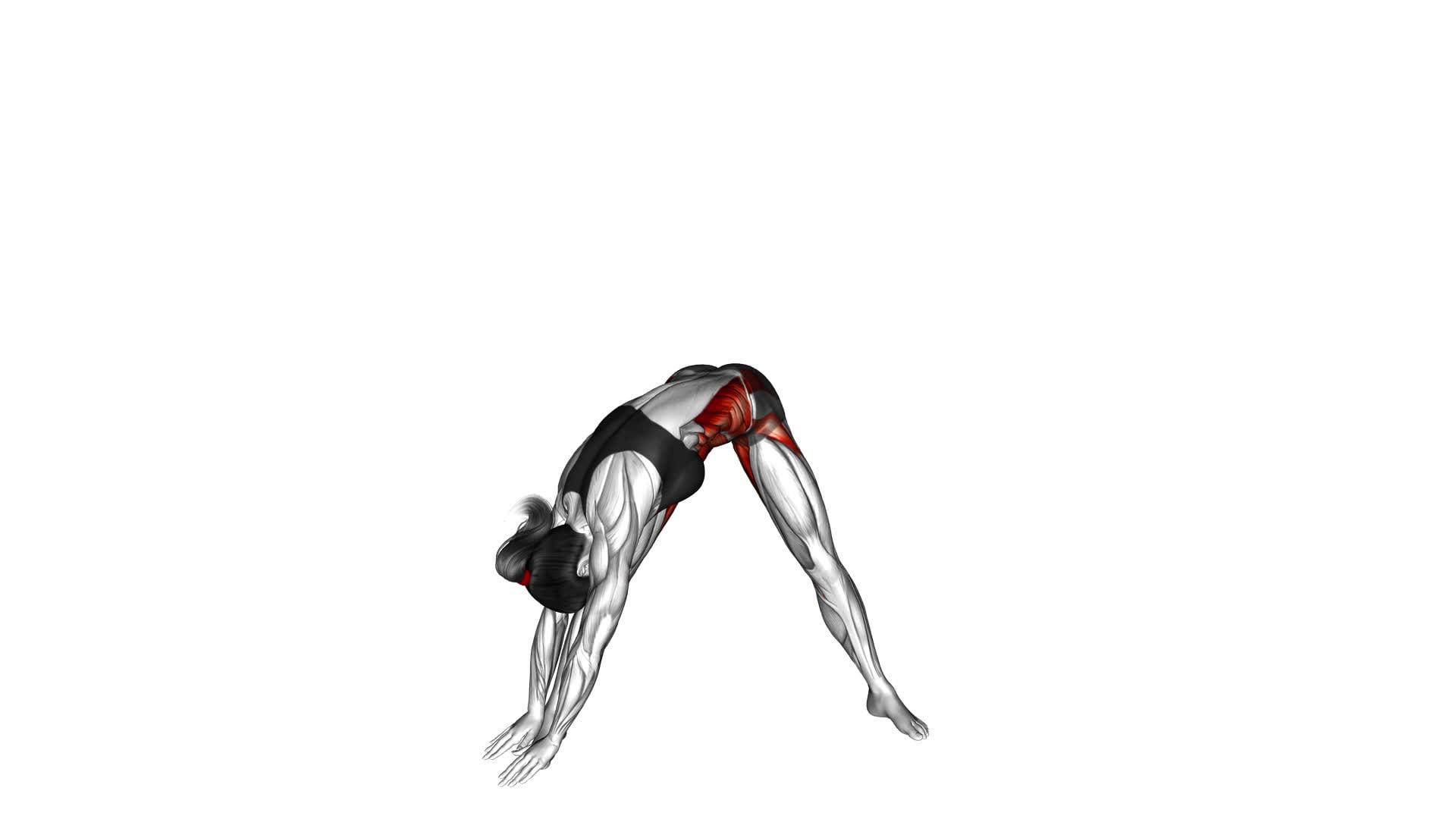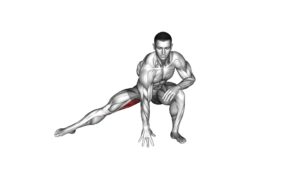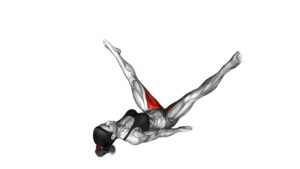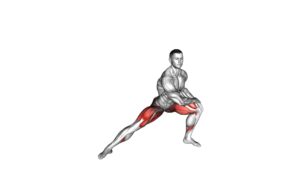Standing Adductor Stretch (female) – Video Exercise Guide & Tips

Are you looking to improve your flexibility and strengthen your adductors? Look no further than the Standing Adductor Stretch!
Watch This Exercise Video
In this video exercise guide, we'll show you the proper form and technique to get the most out of this stretch. We'll also share common mistakes to avoid, modifications for all fitness levels, and tips for maximizing its effectiveness.
Add the Standing Adductor Stretch to your workout routine for great results!
Key Takeaways
- Increased flexibility and improved range of motion in adductor muscles
- Targets inner thigh muscles (adductors) that stabilize hips and pelvis
- Prevents muscle imbalances and pain in hips, lower back, and knees
- Reduces the risk of dysfunction in the lower body
Benefits of the Standing Adductor Stretch
You can experience increased flexibility and improved range of motion in your adductor muscles by regularly performing the standing adductor stretch. This stretch specifically targets the inner thigh muscles, known as the adductors, which play a crucial role in stabilizing the hips and pelvis. By improving flexibility in the adductors, you can prevent muscle imbalances that can lead to pain and dysfunction in the hips, lower back, and knees.
The standing adductor stretch is a simple yet effective exercise that can be done anywhere with enough space. To perform this stretch, stand with your feet shoulder-width apart and take a wide step to the side with your right foot. Keep your left foot planted firmly on the ground and shift your weight onto your right leg. Slowly bend your right knee and lower your body down towards the ground, feeling a stretch in your inner thigh. Hold this position for 20-30 seconds and then switch sides.
By incorporating the standing adductor stretch into your regular exercise routine, you can improve flexibility in your adductor muscles, reduce the risk of muscle imbalances, and enhance your overall mobility.
Now, let's dive into the proper form and technique for this stretch.
Proper Form and Technique for the Stretch
To properly perform the standing adductor stretch, begin by positioning your feet shoulder-width apart and taking a wide step to the side with your right foot. Keep your toes pointed forward and your left foot facing straight ahead. Engage your core muscles to maintain proper form and alignment throughout the stretch.
Here are some key points to consider for proper form and technique:
- Keep your back straight and upright, avoiding any excessive leaning or rounding of the spine.
- Slowly lower your body down by bending your right knee, while keeping your left leg straight and extended.
- Aim to feel a gentle stretch in your inner thigh and groin area. Don't push yourself to the point of pain.
- Breathe deeply and exhale as you sink deeper into the stretch. This will help promote relaxation and release tension in the muscles.
- Hold the stretch for 20-30 seconds, then slowly return to the starting position.
Maintaining proper form, alignment, and breathing techniques are essential for maximizing the benefits of the standing adductor stretch. By practicing this stretch regularly, you can improve flexibility in your adductor muscles, reduce the risk of muscle imbalances, and enhance overall lower body mobility. Remember to listen to your body and adjust the intensity of the stretch as needed.
Common Mistakes to Avoid
One common mistake to avoid when performing the standing adductor stretch is allowing your back to round or lean excessively. Maintaining proper posture is essential to target the adductor muscles effectively and prevent injury.
Another mistake to avoid isn't engaging the core muscles. Your core helps stabilize your body during the stretch and allows for better control and balance. Failing to engage the core can result in a less effective stretch and potential strain on other muscles.
Another common error is rushing through the stretch or not holding it for the recommended duration. The recommended hold time for the standing adductor stretch is 30 seconds to 1 minute. Rushing through the stretch can limit its effectiveness and may not provide the desired results. It's important to take your time and ensure that you're properly stretching the adductor muscles.
Lastly, using improper form can lead to incorrect muscle activation and potential injury. Avoid leaning too far forward or backward, as this can put stress on the lower back and compromise the stretch. Additionally, avoid locking your knees during the stretch, as this can strain the joints. Maintain a slight bend in the knees to reduce stress on the knees and promote proper muscle engagement.
Modifications and Variations for All Fitness Levels
To modify the standing adductor stretch for all fitness levels, incorporate variations that cater to different abilities and flexibility levels. Fitness modifications can be made to ensure that individuals of all fitness levels can benefit from this exercise.
Here are some advanced variations to challenge those who are more experienced:
- Weighted Standing Adductor Stretch: Hold a dumbbell or kettlebell in one hand while performing the stretch. This added resistance will increase the intensity and difficulty of the exercise.
- Elevated Standing Adductor Stretch: Stand on a step or platform with one foot, keeping the other foot on the ground. This modification increases the range of motion and stretches the adductor muscles from a different angle.
- Dynamic Standing Adductor Stretch: Instead of holding the stretch position, perform a dynamic movement by repeatedly opening and closing the legs. This variation helps to improve flexibility and muscular endurance.
- Single-Leg Standing Adductor Stretch: Stand on one leg while performing the stretch, keeping the other leg lifted off the ground. This modification challenges balance and stability while targeting the adductor muscles.
- Resistance Band Standing Adductor Stretch: Place a resistance band around the legs, just above the knees, and perform the stretch. The band provides external resistance, making the exercise more challenging.
Incorporating these advanced variations into your standing adductor stretch routine will help you progress and continue to challenge your muscles. Remember to listen to your body and choose modifications that are appropriate for your fitness level.
Tips for Maximizing the Effectiveness of the Stretch
To maximize the effectiveness of the standing adductor stretch, it's important to focus on proper form and alignment. Keep your back straight, engage your core, and ensure that your knees are aligned with your toes.
Additionally, incorporating breathing techniques can help relax your muscles and deepen the stretch. Remember to inhale deeply as you prepare for the stretch and exhale slowly as you deepen into it.
Proper Form and Alignment
Ensure that your feet are hip-width apart and your toes are pointing forward. This will help establish proper form and alignment for the standing adductor stretch.
Here are some alignment tips to maximize the effectiveness of the stretch and avoid common mistakes:
- Keep your back straight and your shoulders relaxed.
- Engage your core muscles to maintain stability throughout the stretch.
- Avoid leaning forward or backward, as this can compromise the alignment of the stretch.
- Make sure your knees are in line with your toes to prevent strain on the knees.
- Maintain a steady and controlled movement, avoiding any jerking or bouncing motions.
By following these alignment tips, you can ensure that you're getting the most out of your standing adductor stretch.
Now, let's move on to breathing techniques for relaxation.
Breathing Techniques for Relaxation
To maximize the effectiveness of the stretch and promote relaxation, incorporate proper breathing techniques during the standing adductor stretch. Breathing exercises play a crucial role in stress relief techniques, helping to calm the mind and relax the body.
As you perform the standing adductor stretch, focus on deep breathing to enhance the relaxation benefits. Inhale deeply through your nose, allowing your belly to expand. As you exhale, imagine releasing any tension in your muscles. Try to prolong the exhalation, as this can activate the body's relaxation response.
Incorporating the Standing Adductor Stretch Into Your Workout Routine
Start by incorporating the standing adductor stretch into your workout routine two to three times a week. This stretch targets the muscles of the inner thighs, helping to improve flexibility and prevent injury. To incorporate the standing adductor stretch effectively, consider the following:
- Stand with your feet shoulder-width apart, keeping your back straight.
- Take a wide step to the side with your right leg, keeping your toes pointing forward.
- Shift your weight to your right side, bending your right knee and keeping your left leg straight.
- Lean your upper body towards your right leg, feeling a stretch in your inner thigh.
- Hold the stretch for 15 to 30 seconds, then repeat on the other side.
By incorporating the standing adductor stretch into your workout routine, you can experience several benefits:
- Increased flexibility in the inner thigh muscles.
- Improved range of motion in the hips.
- Reduced risk of adductor strains and other lower body injuries.
- Enhanced performance in exercises that rely on inner thigh strength.
- Promotion of proper alignment and posture during workouts.
Incorporating stretches into a warm-up routine is crucial to prepare your muscles for exercise and prevent injuries. Adding the standing adductor stretch to your warm-up can help activate and warm up the muscles of the inner thighs, ensuring they're ready for the demands of your workout.
Frequently Asked Questions
How Long Should I Hold the Standing Adductor Stretch?
When doing the standing adductor stretch, it's important to hold the stretch for an adequate amount of time to maximize its benefits. The duration of the stretch will depend on your flexibility and comfort level, but generally, holding the stretch for 30 seconds to 1 minute is recommended.
This allows for an effective stretch of the adductor muscles, promoting flexibility and preventing injury.
Can I Do the Standing Adductor Stretch if I Have a Knee Injury?
Yes, you can modify the standing adductor stretch if you have a knee injury. Instead of standing, try doing the stretch while sitting on a chair or on the floor with your legs straight out in front of you. This will reduce the strain on your knees.
Additionally, there are alternative stretches you can do that focus on the adductor muscles without putting excessive pressure on your knees. Some examples of these stretches are the seated butterfly stretch or the lying down butterfly stretch.
Is It Normal to Feel Discomfort During the Standing Adductor Stretch?
Feeling discomfort during the standing adductor stretch isn't uncommon. It's important to listen to your body and make adjustments if necessary.
If the discomfort persists, you may want to consider alternative stretches or exercises that target the adductor muscles. Some alternatives include seated adductor stretches or using a resistance band for adductor exercises.
Consult a fitness professional or physical therapist for personalized guidance and to ensure you're performing the exercises safely and effectively.
Can the Standing Adductor Stretch Help With Improving Flexibility in Other Areas of the Body?
Improving overall flexibility is essential for your fitness journey. The standing adductor stretch offers numerous benefits that extend beyond just the adductor muscles. By targeting these muscles, you're also indirectly working on improving flexibility in other areas of your body.
This stretch helps to lengthen and loosen the muscles, allowing for a wider range of motion. Incorporating the standing adductor stretch into your routine can contribute to enhanced overall flexibility and better performance in various activities.
Are There Any Specific Warm-Up Exercises That Should Be Done Before Performing the Standing Adductor Stretch?
Before performing the standing adductor stretch, it's important to do specific warm-up exercises. These exercises help prepare your body for the stretch and reduce the risk of injury.
Some effective warm-up exercises include light jogging, jumping jacks, and hip circles. These activities increase blood flow to your muscles and improve their flexibility.
Conclusion
Incorporating the standing adductor stretch into your workout routine can provide numerous benefits for your flexibility and overall athletic performance. By practicing proper form and technique, avoiding common mistakes, and making modifications based on your fitness level, you can maximize the effectiveness of this stretch.
Remember to follow the video exercise guide and tips to ensure you're performing the stretch correctly.
Start incorporating the standing adductor stretch into your routine today to improve your lower body flexibility.

Author
Years ago, the spark of my life’s passion ignited in my mind the moment I stepped into the local gym for the first time. The inaugural bead of perspiration, the initial endeavor, the very first surge of endorphins, and a sense of pride that washed over me post-workout marked the beginning of my deep-seated interest in strength sports, fitness, and sports nutrition. This very curiosity blossomed rapidly into a profound fascination, propelling me to earn a Master’s degree in Physical Education from the Academy of Physical Education in Krakow, followed by a Sports Manager diploma from the Jagiellonian University. My journey of growth led me to gain more specialized qualifications, such as being a certified personal trainer with a focus on sports dietetics, a lifeguard, and an instructor for wellness and corrective gymnastics. Theoretical knowledge paired seamlessly with practical experience, reinforcing my belief that the transformation of individuals under my guidance was also a reflection of my personal growth. This belief holds true even today. Each day, I strive to push the boundaries and explore new realms. These realms gently elevate me to greater heights. The unique combination of passion for my field and the continuous quest for growth fuels my drive to break new ground.







